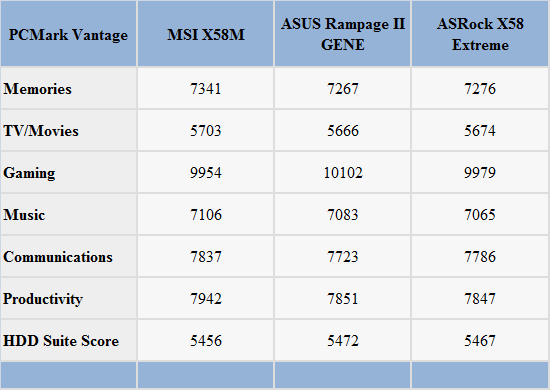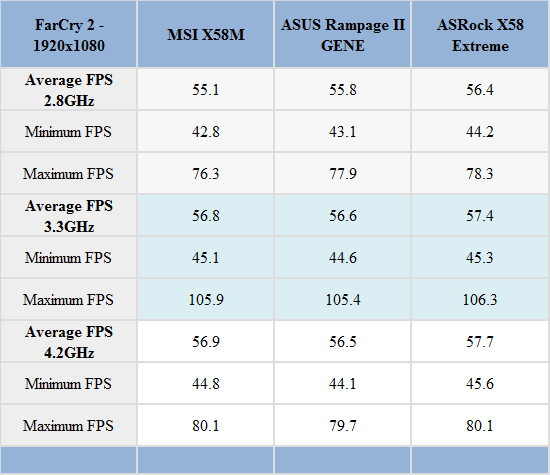ASRock X58 Extreme - $169.99 is not too Extreme
by Gary Key on July 2, 2009 12:00 PM EST- Posted in
- Motherboards
General Performance – PCMark Vantage
Futuremark's PCMark Vantage x64 is probably the single most diverse set of standardized benchmarks one can run on a system to mimic real world usage scenarios. The TV and Movies, Gaming, and Music Suites can be frighteningly difficult to pass when a system is not set up correctly. We've had boards in the labs that will pass hours of Prime95 torture testing or OCCT that fail even the basic 30 minute run of PCMark Vantage, let alone the full 1 hour and 30 minute test run that we loop five times.

The X58 Extreme performed admirably in this benchmark with overall results slightly trailing the MSI and ASUS boards. However, the user will never notice the minimal performance differences in actual usage between all three boards. We fired up our application benchmarks from the full review test suite and in each case, the ASRock board trailed slightly (never more than 1%) in applications ranging from Sony Vegas Pro 9.0 to AutoCAD 2009. Obviously, price to performance ratios with the board are very good, but just under the MSI offering.
Gaming Performance – FarCry 2
This title has beautiful graphics, an open ended environment, and is fun to play. If you dial up the graphics options, the game rewards with you some fantastic visuals courtesy of the Dunia Engine. The game also features the most impressive benchmark tool we have seen in a PC game. We set the performance feature set to Very High, graphics to High, and enable DX10 with AA set to 2x. The in-game benchmark tool is utilized with the Ranch Small level and we report an average of three test runs.

The press information from ASRock indicated excellent graphics performance with this board and in this particular game title, it does not disappoint. We have noticed the same pattern at 1680x1050 and in other games in early testing.
First Thoughts –
ASRock went back to the X58 drawing board and it shows. At a $169.99 price tag, we expected a motherboard lacking in features or performance. However, ASRock added features ranging from handy rest/power/CMOS switches to a very good 8-phase power supply along with just about every standard option a user expects on higher-end boards. Performance is very solid and even overclocking does not disappoint, certainly not for users on air or self-contained water cooling solutions.
The board tends to have higher Vdroop (.04~.05V) than the MSI or Gigabyte (.02~.03V) boards in this price sector, you can disable Vdroop although we recommend against it. There are some inconsistencies in the BIOS feature descriptions in the voltage section. We would have preferred better memory performance above DDR3-1600 speeds, not so much for application performance improvements as they are minimal, but we tended to use slightly higher VDimm/VTT voltages than we did on the MSI board at like settings. S3 resume works properly and ASRock now offers basic fan speed control on each header although temperature based control is still missing.
At this point in testing, we have found no obvious reasons not to recommend the X58 Extreme for users seeking balanced performance and features at a very reasonable price point, well, for X58 products. The board does not have the overclocking prowess of more expensive boards but it will not embarrass you either. We tend to look at the overall aspects of a product and the company building it instead of focusing on Super Pi or 3DMark numbers. As such, it appears that ASRock has delivered another outstanding product for the budget hunter in all of us.










44 Comments
View All Comments
SunSamurai - Thursday, July 2, 2009 - link
Gary Key, if this were not a tech site then such aesthetics would not really matter, but seeing as this IS a tech site and one might ponder credibility, please use the appropriate codecs!Thank you and another great article.
Ryun - Friday, July 3, 2009 - link
Why is .jpg bad? I'm legitimately curious.UNHchabo - Thursday, July 2, 2009 - link
For tables, .png files would likely be smaller, too.DeepThought86 - Thursday, July 2, 2009 - link
How about adding a 24 100% load stability test for all motherboard reviews. It would really be useful to get a feel for the motherboard's quality and VRM robustness.Use the highest clocked supported proc and see if anything crashes.
Gary Key - Friday, July 3, 2009 - link
We loop various applications (multitask) to keep CPU utilization above 95% on all cores at our overclock settings for approximately 100 hours of actual testing and 200 hours at stock settings. We do this to ensure the entire platform is being stressed and not just one particular area such as the CPU (memory to some degree) with various programs like LinX (Linpack front end), OCCT, and others that concentrate on the CPU.While these programs will also stress the VRM to some degree, in some instances,LinX to be exact,tend to overstress it based on the original Linpack requirements. That is fine for short burst testing but for long term testing it does not represent anything close to the actual VRM loads your system will experience.
That said, we do run all of the various CPU buster programs, but they are just that, CPU centric. We can pass certain hour points that people tend to think is stable with these programs and then watch our first multitask test tank in a few minutes. I tend to stress everything on the platform with actual apps (single/multitask) and call it a day if everything I run does not crash over a 100 hour period.
In the full review I will list out our testing methodology in more detail. Also note, every board, memory, and CPU combination is different. We tend to spend the first day or two with a board dialing all the various components in so the CPU is in the "Zone" when overclocking.
Ryun - Thursday, July 2, 2009 - link
I've known about Asrock for awhile and I see these great boards from them, but they're so hard to recommend because they don't really have much of warranty to speak of. I just put an Asrock 760g in my brother's new computer and the system runs great, cool, and has a wealth of BIOS options.I'd like to get one for myself in the future but the 1-year-return-to-the-retailer-warranty just prevents me from spending anymore than around $80 on one of their boards, let alone $170.
Arbie - Thursday, July 2, 2009 - link
Perceptions of value are relative and everyone has their own standards. But right before reading this comment I was thinking: how can a company produce a piece of technology like this and sell it retail for $170? The design effort, manufacturing equipment, parts cost, build, testing, packaging, documentation, shipping AND the warranty - not to mention dealer profit - make this seem incredible. And that's taking for granted the supporting tech / price achievements of the component suppliers.
Look at what you're getting - the heart of a strong PC that can outperform any computer in the world of 15 years ago, and do it 24/7 for the next 15 years if you ask it to. In contrast, $80 is two tanks of gas.
Really - successfully mass-producing something like this IS rocket science. We tend to lose sight of that fact and fail to appreciate what this industry is doing for us. We need to stop and smell the surface-mount devices once in a while.
If a motherboard is reliable and has the features I want, I'm not going to worry about these differences in price. The true value of the finished PC, to me at least, is many thousands of dollars. Saving $100 or $200 on the motherboard is not important in comparison, and I wouldn't want to have done so. And that's my recommendation for anyone else who would be reading this column.
Arbie
Ryun - Thursday, July 2, 2009 - link
I agree with what you say almost to the letter, but I'm just a more cynical buyer I suppose. My philosophy is that any company that can create a good product can also have a terrible one come off the production line and I just like the companies that I buy from to be accountable and aware of that.If Asrock offered a 3 year warranty there'd be no contest for me. Hell, even if they offered 2 years I'd be happy. You say that we tend to lose sight of the importance of these devices and you're absolute right, most do. I'm just really jaded and skeptical of a products quality no matter where it comes from. I also suspect that the both of us might be different in our financial situations as well. I'm a student that doesn't make much money so if I were to buy an $170 board and it blows after 1 year I'm computer-less.
ap90033 - Thursday, July 2, 2009 - link
Hey is there going to be a guide to help us noobs out here OC our i7 920 Rev D0? There are a zillion settings, and it is to much money to monkey around with without any real guidance.Gary Key - Friday, July 3, 2009 - link
I discussed it with Raja this morning and due to the interest in a "How To" article, we will team up and do one together later this month after I get this floating pile of motherboards reviewed. ;)